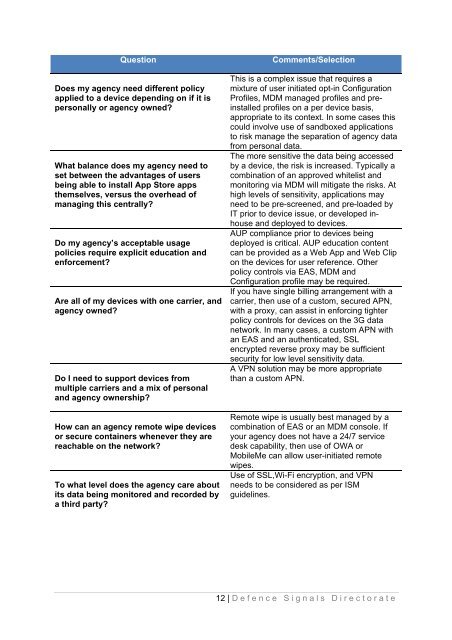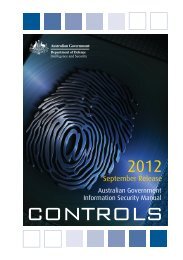iOS Hardening Configuration Guide - DSD
iOS Hardening Configuration Guide - DSD
iOS Hardening Configuration Guide - DSD
You also want an ePaper? Increase the reach of your titles
YUMPU automatically turns print PDFs into web optimized ePapers that Google loves.
Question Comments/Selection<br />
Does my agency need different policy<br />
applied to a device depending on if it is<br />
personally or agency owned?<br />
What balance does my agency need to<br />
set between the advantages of users<br />
being able to install App Store apps<br />
themselves, versus the overhead of<br />
managing this centrally?<br />
Do my agency’s acceptable usage<br />
policies require explicit education and<br />
enforcement?<br />
Are all of my devices with one carrier, and<br />
agency owned?<br />
Do I need to support devices from<br />
multiple carriers and a mix of personal<br />
and agency ownership?<br />
How can an agency remote wipe devices<br />
or secure containers whenever they are<br />
reachable on the network?<br />
To what level does the agency care about<br />
its data being monitored and recorded by<br />
a third party?<br />
This is a complex issue that requires a<br />
mixture of user initiated opt-in <strong>Configuration</strong><br />
Profiles, MDM managed profiles and preinstalled<br />
profiles on a per device basis,<br />
appropriate to its context. In some cases this<br />
could involve use of sandboxed applications<br />
to risk manage the separation of agency data<br />
from personal data.<br />
The more sensitive the data being accessed<br />
by a device, the risk is increased. Typically a<br />
combination of an approved whitelist and<br />
monitoring via MDM will mitigate the risks. At<br />
high levels of sensitivity, applications may<br />
need to be pre-screened, and pre-loaded by<br />
IT prior to device issue, or developed in-<br />
house and deployed to devices.<br />
AUP compliance prior to devices being<br />
deployed is critical. AUP education content<br />
can be provided as a Web App and Web Clip<br />
on the devices for user reference. Other<br />
policy controls via EAS, MDM and<br />
<strong>Configuration</strong> profile may be required.<br />
If you have single billing arrangement with a<br />
carrier, then use of a custom, secured APN,<br />
with a proxy, can assist in enforcing tighter<br />
policy controls for devices on the 3G data<br />
network. In many cases, a custom APN with<br />
an EAS and an authenticated, SSL<br />
encrypted reverse proxy may be sufficient<br />
security for low level sensitivity data.<br />
A VPN solution may be more appropriate<br />
than a custom APN.<br />
Remote wipe is usually best managed by a<br />
combination of EAS or an MDM console. If<br />
your agency does not have a 24/7 service<br />
desk capability, then use of OWA or<br />
MobileMe can allow user-initiated remote<br />
wipes.<br />
Use of SSL,Wi-Fi encryption, and VPN<br />
needs to be considered as per ISM<br />
guidelines.<br />
12 | D efence Signals Directorate



